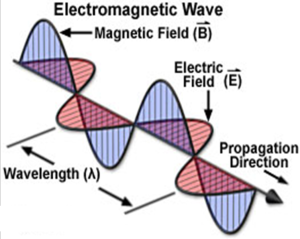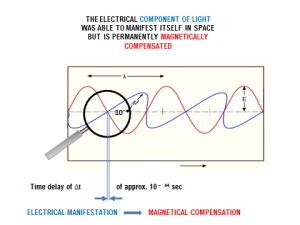The historical path of a photon through space in an electromagnetic form as radiation is a sinusoïd for both the electric and the magnetic manifestation, perpendicular to one another.
Illustrated in graphical form:
Both manifestations linked to the entity are in phase and symmetric, reflected in Maxwell’s equations as well.
The assumption that the electric component was uncompensated in the second period at the Big Bang has as a consequence that as from the third period, these two manifestations of electric and magnetic nature are not in total phase synchronization anymore. The two components show a small phase shift in time.
Graphically illustrated:
This time delay is fixed and assumed to be equal to 1 Planck time. The magnetic compensation had the capability for full compensation of the electric manifestation per entity before the Big Bang, but the magnetic component of the causal system came into a backlog of exercising this capability due to the small shift in time. The magnetic compensation is as from that moment on always too late. It is the transformation from virtual, non-observable instant causality into time-delayed observable causality. In the illustration, the electric component is under-compensated by the magnetic component while approaching equality and pass through zero to start an opposite behavior relative to its original character. This pattern of under- and overcompensating is perpetual. For a naked photon, the overall result is neutrality in electric and magnetic exposure to the outside world. Being electromagnetic radiation, this is a well-known characteristic of photonic light.
The total amount of free electric energy for each photon is incorporated by this small time delay of the Planck time and is relative to the wave frequency, being hF.


